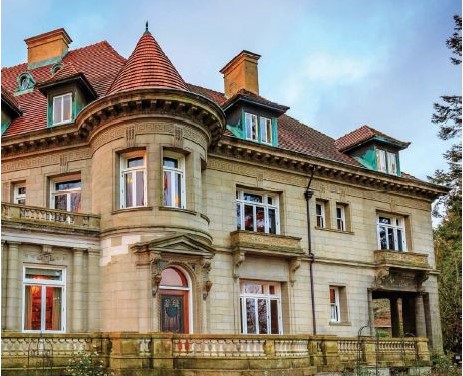
This article originally appeared in the May/June 2017 issue of Museum magazine.
Built in 1914 by an influential Portland newspaper publisher, Pittock Mansion has a story similar to that of many other early 20th-century mansions across the United States. The original residents passed away, and high maintenance costs combined with societal changes made owning an elaborate mansion unappealing. In 1958, when the last Pittock descendants moved out and put the home up for sale, few buyers took interest in the empty 16,000-square-foot French chateau overlooking the city.
With the mansion facing potential demolition, a group of dedicated citizens worked with city officials to purchase and restore the home and surrounding acreage to their former glory. After the effort devoted to physically saving Pittock Mansion, however, Portland faced the challenge of how to utilize the estate and ensure its preservation for generations to come.
Pittock Mansion opened to the public in 1965. Three years later, the nonprofit Pittock Mansion Society was formed to oversee and care for the increasing number of artifact donations. Initially, Portland operated the mansion to showcase community-loaned or donated antiques, including heirlooms from other prominent local families. The city added a holiday decoration event to the museum’s business model. Attendance remained steady at around 35,000 per year through the 1970s and grew to roughly 64,000 in the 1990s, with the annual holiday event accounting for one-third of visitation.
In the early 2000s, attendance dropped slightly, to roughly 60,000 a year. At the same time, the City of Portland faced increasing budgetary constraints. As a result, the city transferred responsibility for the museum’s day-to-day operations, including programs, exhibits, and staffing, to the Pittock Mansion Society in 2007. The city retained ownership and responsibility for the buildings and grounds.
The society then began to assess whether its focus on its collection of decorative arts would generate enough revenue to cover operating costs and collections care, as well as to fund future growth. In 2008, a snowstorm shut down the museum for 10 days during the holiday season. The society realized it needed to increase visitation throughout the year and therefore decrease reliance on the holiday event.
Developing a Strategic Plan
Now responsible for the visitor experience, the society began work on a strategic plan. The plan utilized the Pittock family as a catalyst for learning about Portland’s history, including its transformation from an Oregon Territory settlement to a modem, industrialized city. As the museum’s existing mission statement, “We bring Pittock Mansion to life for all,” did not align with the society’s goal to focus on Portland history, the society adopted a new one: “to inspire understanding and stewardship of Portland history through Pittock Mansion, its collections, and programs.” As former board member Randy Stevens explains, “We knew that Oregon history was prominent at other local museums and attractions, but Portland’s history wasn’t. So, what better way to change the look and feel of the mansion than to tell the story of the city in which it is located?”
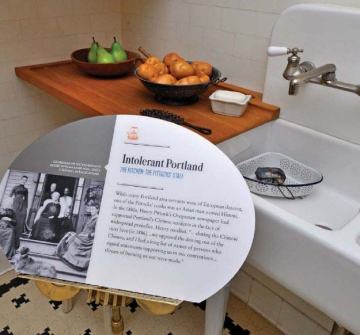
understand Pittock family connections to Portland history.
The new strategic plan also included a master plan to enhance the visitor experience, with laudable goals to increase annual visitation by 50 percent and distribute it more evenly throughout the year. But how could this historic house museum increase its attendance from 60,000 to 90,000 while relying less on its holiday event? What possible changes to the business model could achieve this? Short-term options included discounting admission, renting out the house, and opting for programming choices that were simply popular, versus mission-related, such as wine tastings, “haunted mansion” tours, high tea service, and yoga classes.
Rather than tum the mansion into an event space, the society needed to develop a long-term plan that would lay the foundation for future growth. Inspired by cultural institutions that had adopted visitor-centered strategies to increase community impact and income—such as Lan Su Chinese Garden in Portland; Conner Prairie in Fishers, Indiana; and Brucemore in Cedar Rapids, Iowa, the society decided to start by asking visitors what they wanted.
Gathering the Data
How do we develop a deep, meaningful connection with visitors? Find out who they are and what interests them, then make decisions guided by the “happy visitor” concept. Happy visitors come back, spread positive word-of-mouth information, and ultimately generate more resources and sustainability for an organization.
At first glance, this approach appears simple, but appearances can be deceiving. What are the right questions? How do we ask them? Who does the work? With limited staff, the society concluded that its best initial investment would be to team up with consultants and hired a team led by Dialogue Consulting. The resultant visitor surveys and outreach, conducted by Visitor Studies Services, produced more than 160 pages of data. Responses from both visitors on-site and potential visitors were in some ways affirming, in other ways surprising, and overall extremely valuable.
The data showed that repeat visitors frequently brought out-of-town guests with them, facilitating visits from outside the community. It also revealed that visitors made strong personal connections, often with particular rooms. Some respondents shared specific interests, such as “I’m very interested in Portland history” and “having more info on both the ‘upstairs’ and the ‘downstairs’ people would be engaging.” One respondent wanted “more information on period methods, fixtures, how stuff worked. etc.” Another asked. “Are there programs that illuminate the Pittock family history and provide connections to my current life in Portland?” Roughly 27 percent responded that they simply wanted more than decorative arts and Pittock family anecdotes—more information, more photos, and greater access to parts of the house.
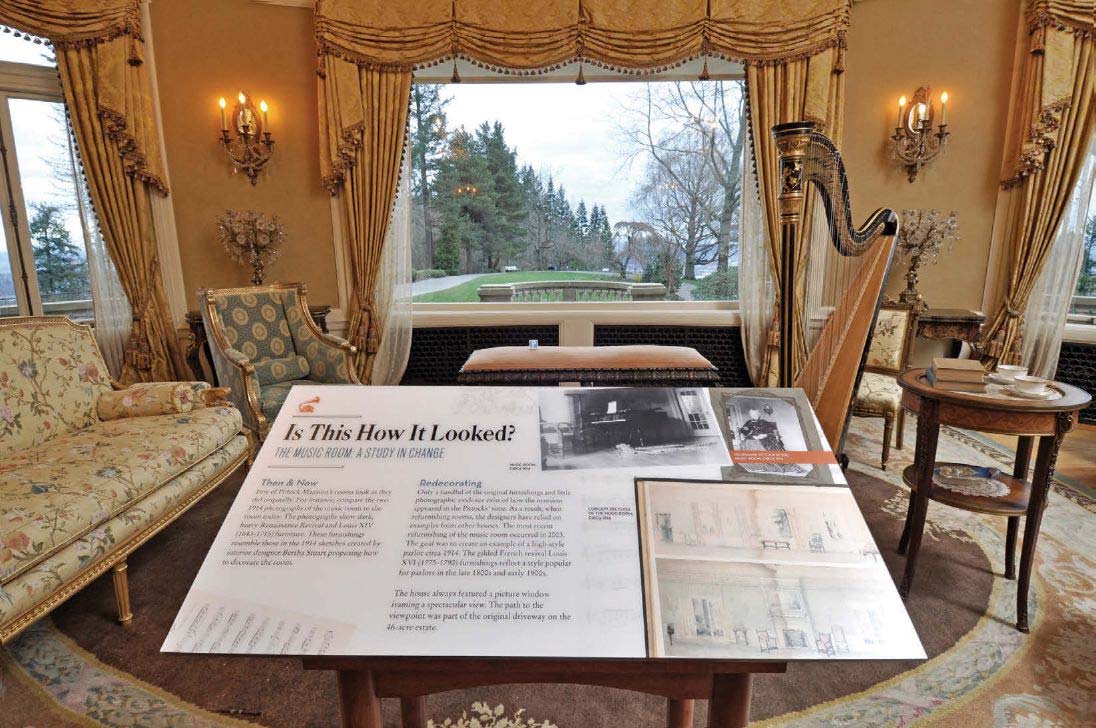
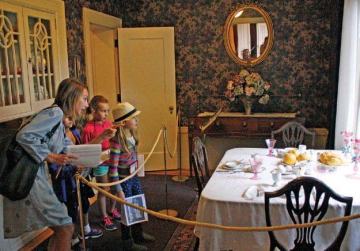
One particularly illuminating piece of data came from a question regarding educational offerings: 41 percent of the respondents wanted guided tours, while more than half preferred self-guided tours. That 73 percent of respondents wanted refreshments was not overly surprising, considering the mansion sits in a beautiful public park overlooking Portland. Finally, the data reinforced that visitors needed better way-finding information for the museum and surrounding grounds, as well as improved pedestrian flow.
By mid-2012, the society had the results of the visitor outreach to guide its decisions regarding how to enhance and expand the interpretive model. The data also suggested how to give visitors what they wanted and more. The society began to move from research and analysis to development, creation, and implementation. It intended to complete the interpretive changes in 2014, the mansion’s centennial.
Transforming Ideas into Reality
As more than half of the museum’s visitors said that they preferred a self-guided tour, the society prioritized enhancing that experience. At the same time, visitors noted they had strong connections to the exhibits. To balance both needs, the society first focused on deciding which new stories to tell, where to activate new connections, and how best to feature information on interpretive panels without interfering with the existing exhibits.
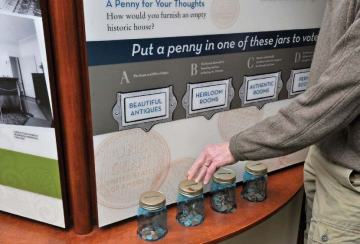
development and curatorial choices.
To make everyone feel welcome, whether they paid to enter the museum or simply came to enjoy the surrounding public park, the society decided to take the Pittock experience outside. Along the roadway leading to the parking lot, the society installed signs that highlighted interesting facts about the Pittocks. Other interpretive signs around the grounds addressed the family’s outdoor activities as well as historic features of the grounds and of Portland.
By extending the experience outdoors, the society intended to inspire a greater interest that would motivate visitors to seek additional experiences and a better understanding of history in general. Some of those experiences could be at Pittock Mansion—a paid visit, a repeat visit, stopping in the museum store—but they could also be at another cultural or historic site in Portland, or even the visitors’ hometowns.
Inside the museum, the new interpretative panels included targeted storylines and showcased many more historic images than they did before. While some panels expanded visitors’ understanding of how the Pittock family lived, others pointed out the home’s often-overlooked technological innovations.
To respond to visitors’ curiosity about the Pittocks and the relevance of their and the mansion’s history to Portland today, the society installed panels in the dressing rooms and closets. These panels provide insight into the original residents’ lives by highlighting stories that tie to Portland’s current values: innovation, connection to the outdoors, commitment to the community, and support of the arts.
“Many people who live in Portland are originally from other places, and the city’s history is a story of pioneers, risk-takers, and travelers,” elaborates former board member Greg Fullem. “We felt that there was a great dynamic at play for us in connecting our curious and quirky local folks—and those who visit our city with the same open spirit—with the local history in a vibrant, interactive museum experience.”
In the master bedroom, the society installed a permanent display to interpret the history of the museum’s development, highlighting curatorial choices made at different times. The exhibit engages visitors by asking them to ponder and choose what they would do if given the same interpretive options.
The inclusion and strategic placement of interpretive panels both inside and out allowed the society to expand the museum’s story and educational offerings while enhancing understanding of its original decorative arts focus. The approach was not about doing away with what had been done before; it was about building upon the current offerings and refocusing on a broader, more compelling story.
It Worked!
With the implementation of the new interpretive model, the society prepared to celebrate the mansion’s 100th anniversary in 2014. After bringing in a record 70,194 visitors in 2013, the society achieved its goal of more than 90,000 visitors in its centennial year. But the true test would come in the years that followed. After all the celebrations and anniversary programs ended, would interest in the museum fade and attendance decline?
If there was any doubt about the new interpretive approach, recent years have removed these traces. Attendance has continued to rise. The mansion welcomed a record-breaking 109,785 visitors in 2016, with the holiday event accounting for just 17,168 visitors.
“It was a delight for me to watch the Pittock team participate deeply in the visitor studies we did together in 2012, but the way they have used the research since then is where the value lies,” Wendy Meluch of Visitor Studies Services stated upon seeing the end results. “The success of the new model leaves the society well positioned to develop the model even further.”
By asking visitors what they wanted and then responding to those requests with a holistic and expanded interpretive model, the society created a foundation for continual engagement. The concept of the “happy visitor” seems like a basic idea, one that usually is connected to the front-of-house experience. Yet when this concept is incorporated into a museum’s business model and interpretive approach, it plants the seeds of connection.
What’s Next?
As visitation remains high, so does the strain on the museum’s staff and infrastructure. To relieve these pressures, continue to provide a quality experience, and enhance that experience even further, the society recently completed a new strategic plan. Current goals include creating programs to deepen engagement and attract new audiences. The society also has developed fundraising and staffing plans to secure the necessary resources to improve the visitor experience and help Portland preserve the estate.
The society’s commitment to a welcoming, respectful, informal, and educational experience resonates with a large and broad audience. Its business model—rooted in the “happy visitor” concept and a focus on Portland history—works. That knowledge strengthens the society’s commitment to continue using this model to launch new programs and engaging activities in the coming years.
Marta E. Bones is executive director of the Pittock Mansion Society in Portland. She can be reached at mbones@pittockmansion.org.







